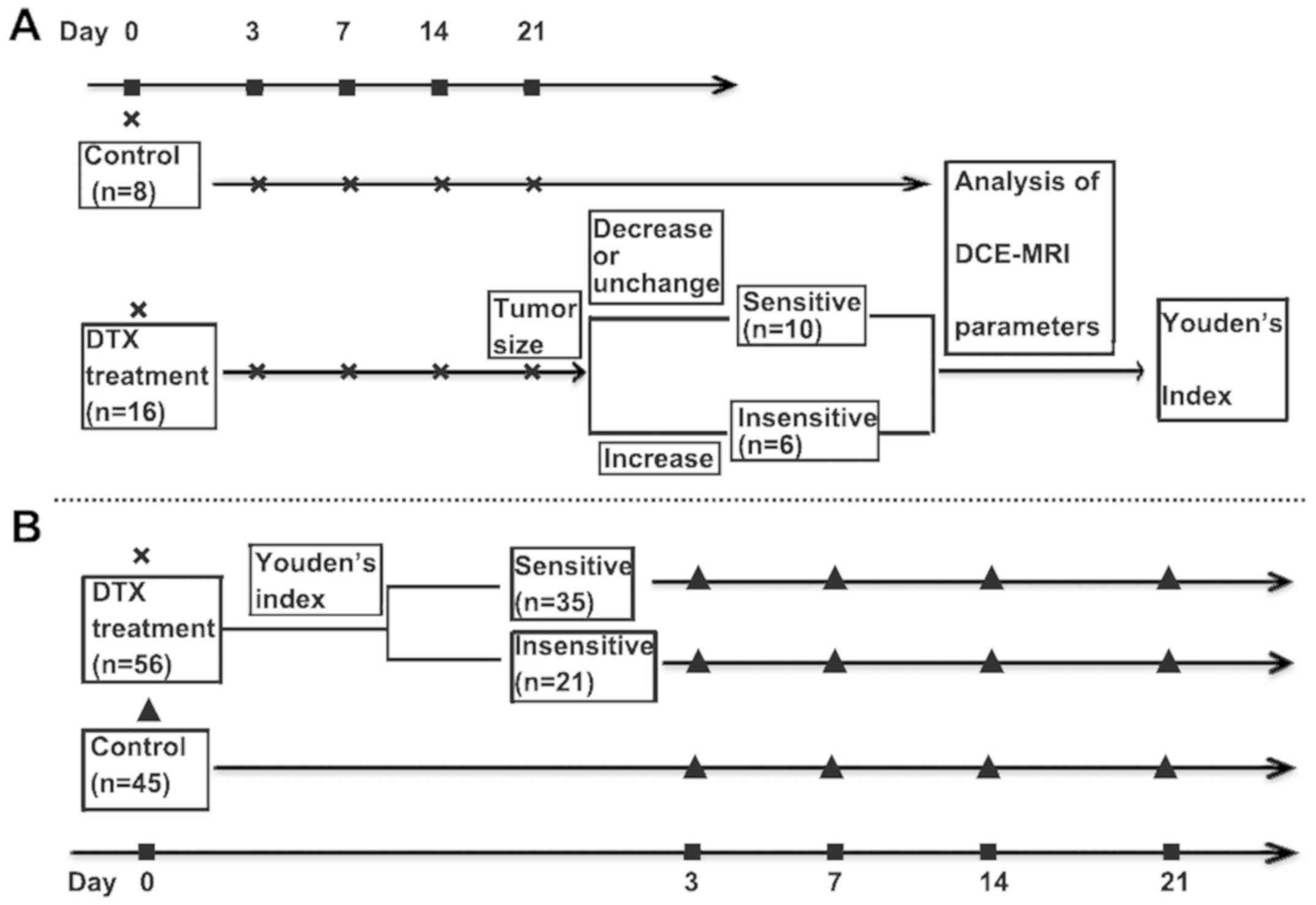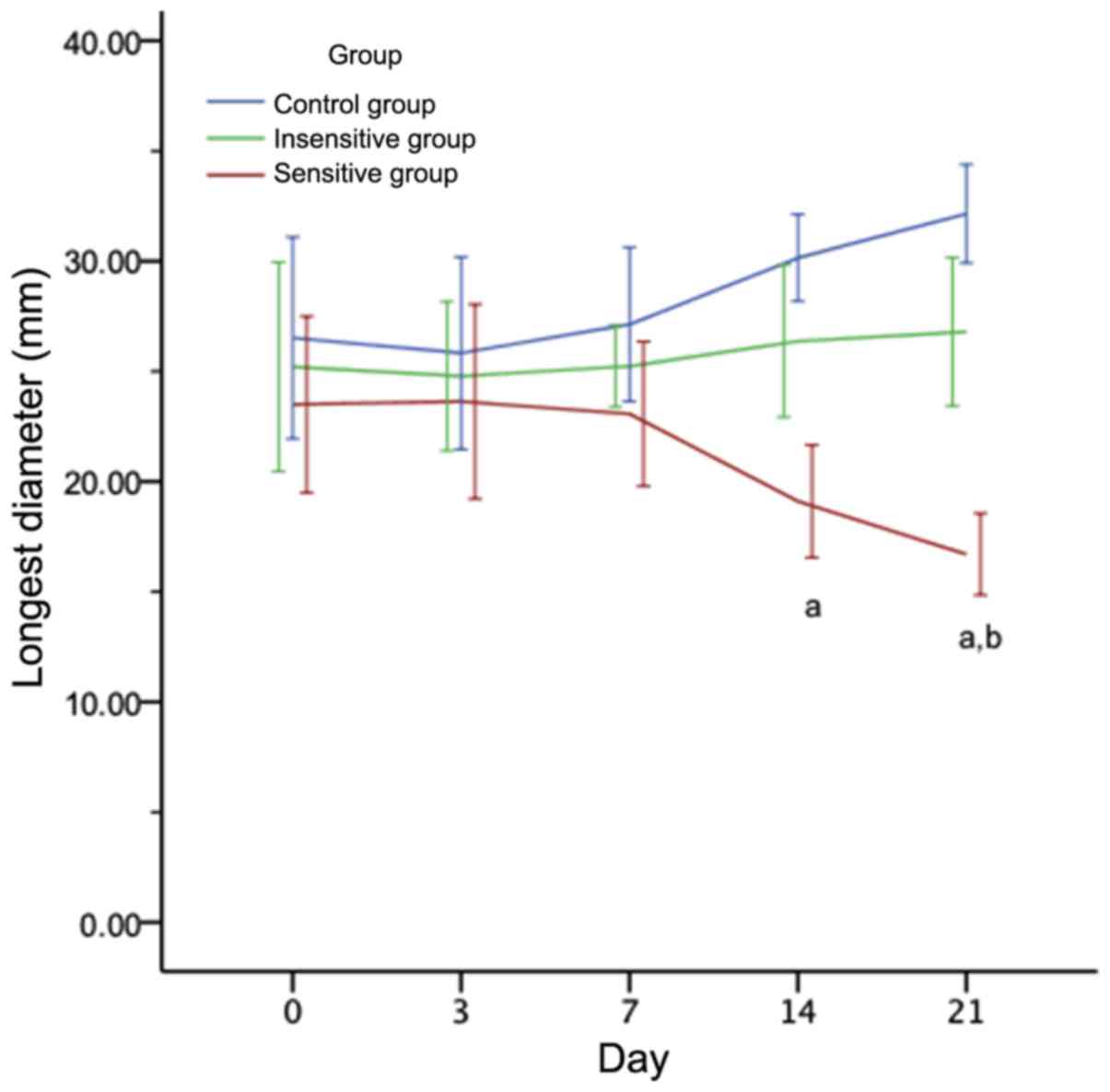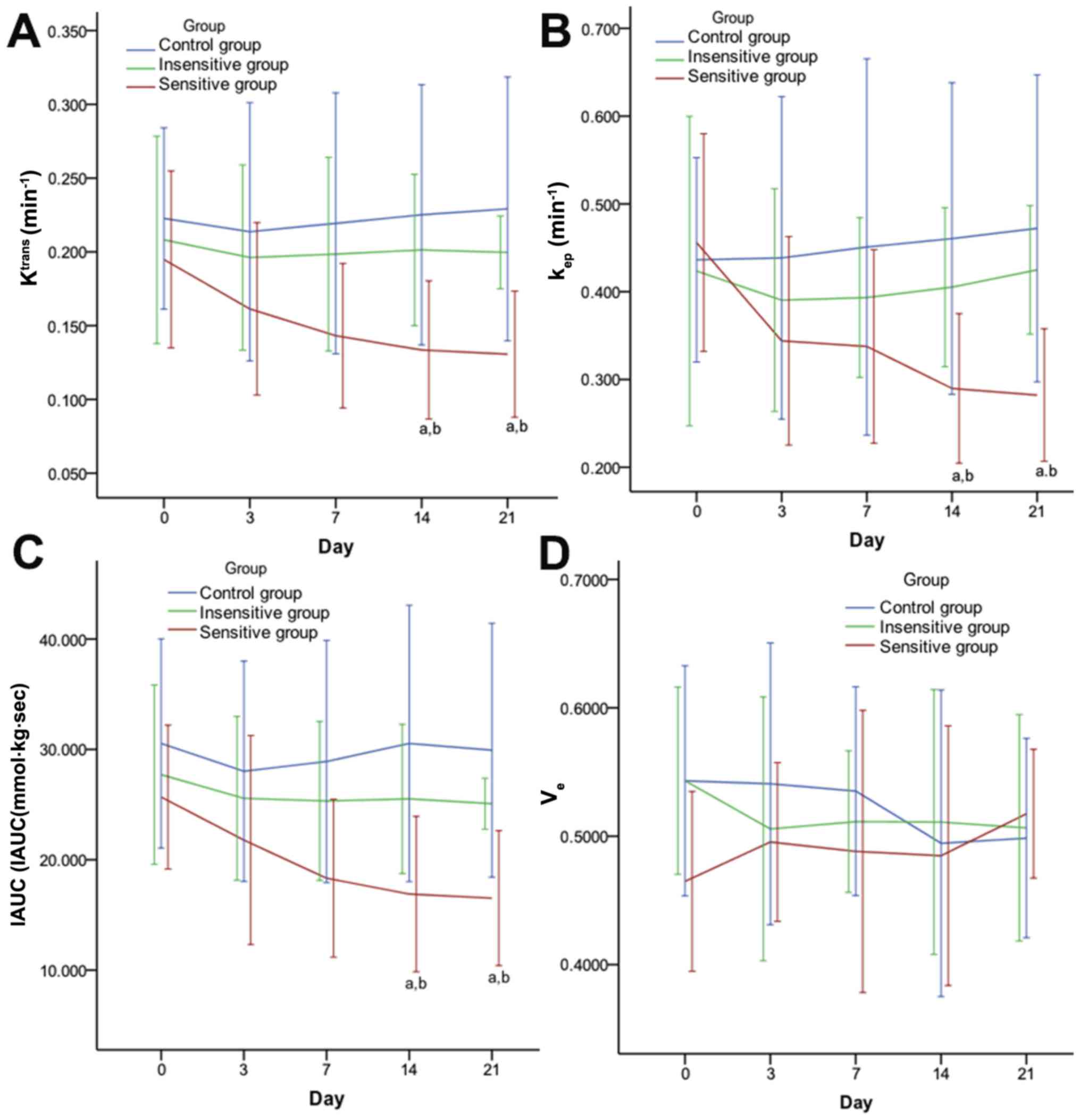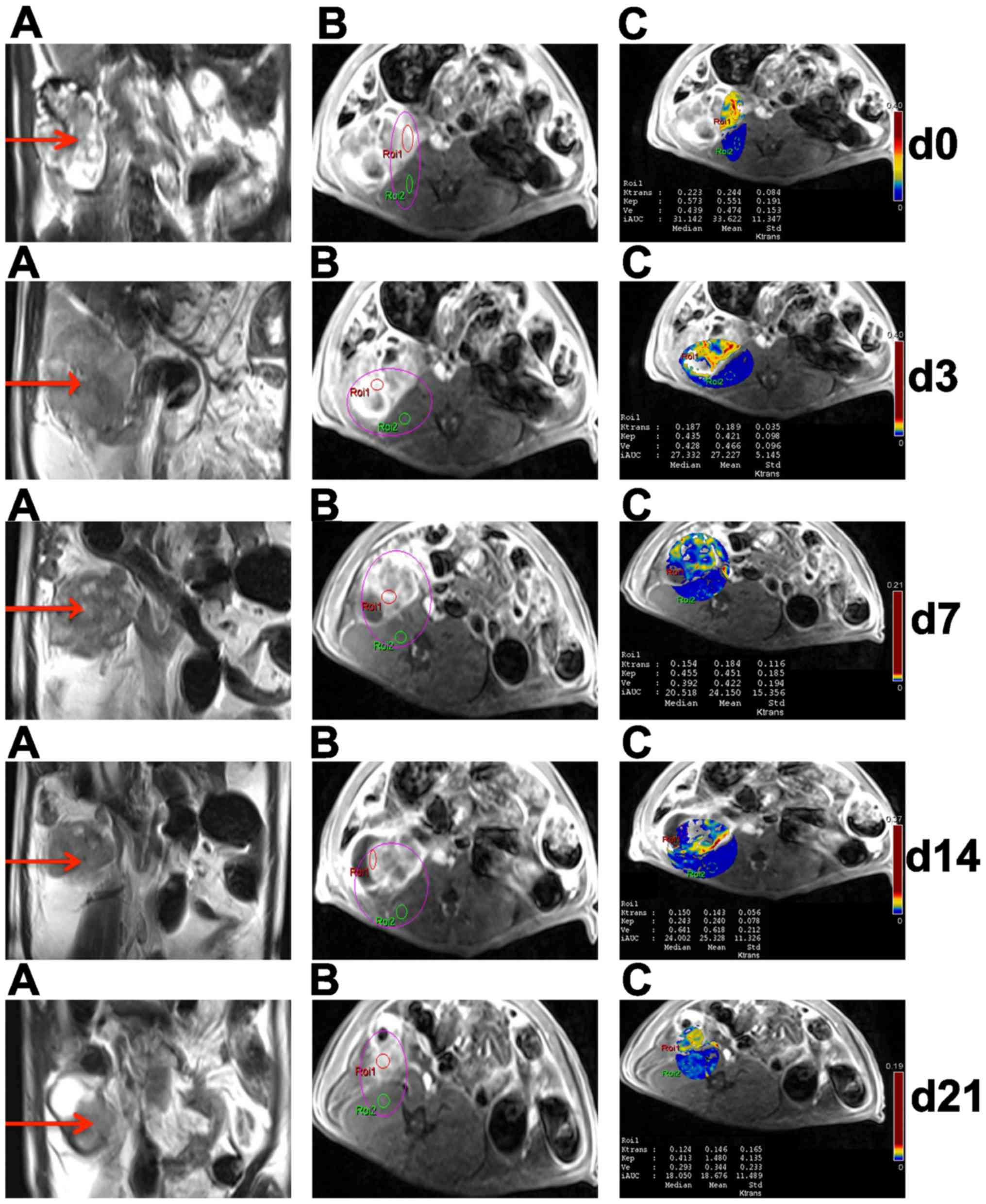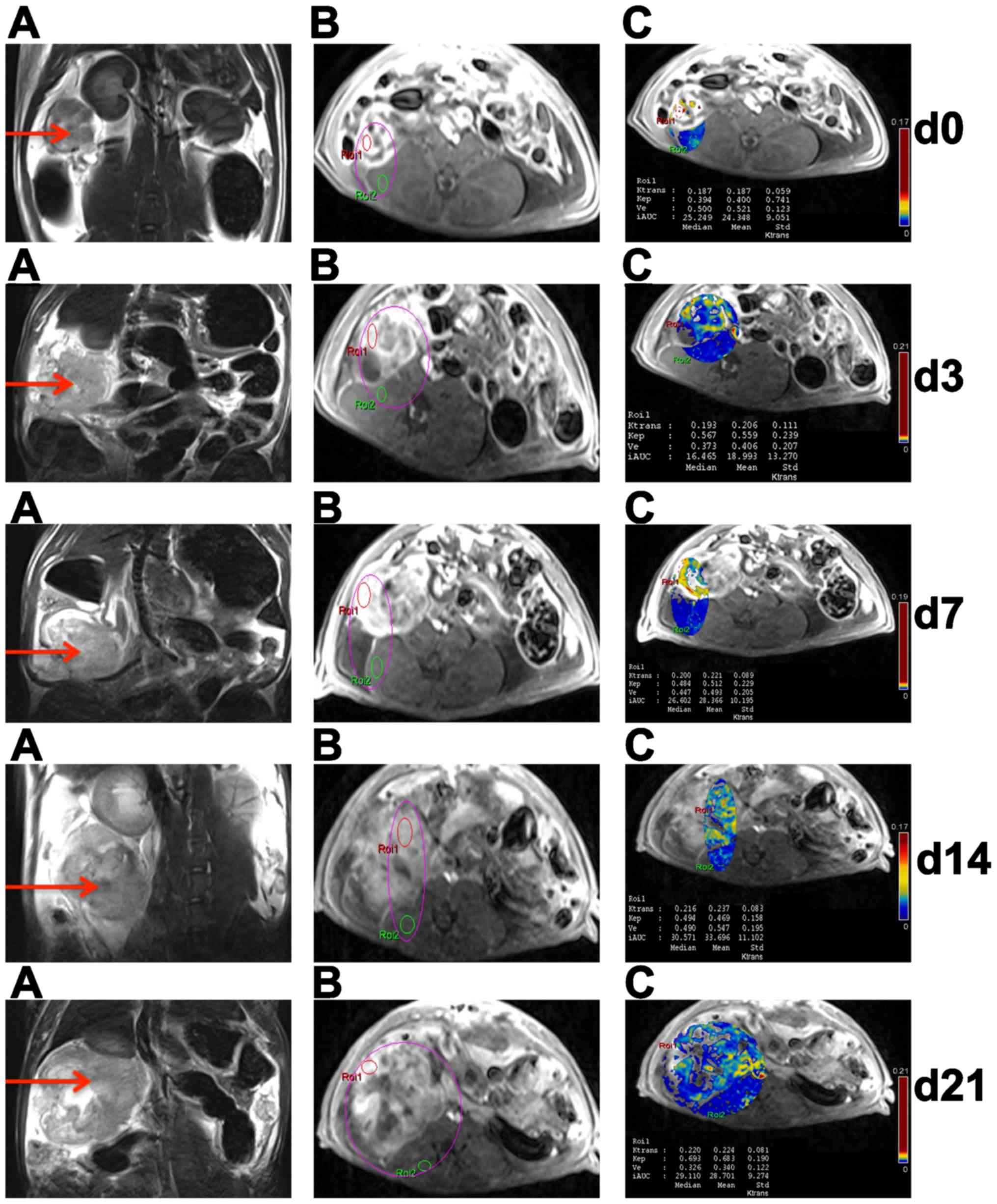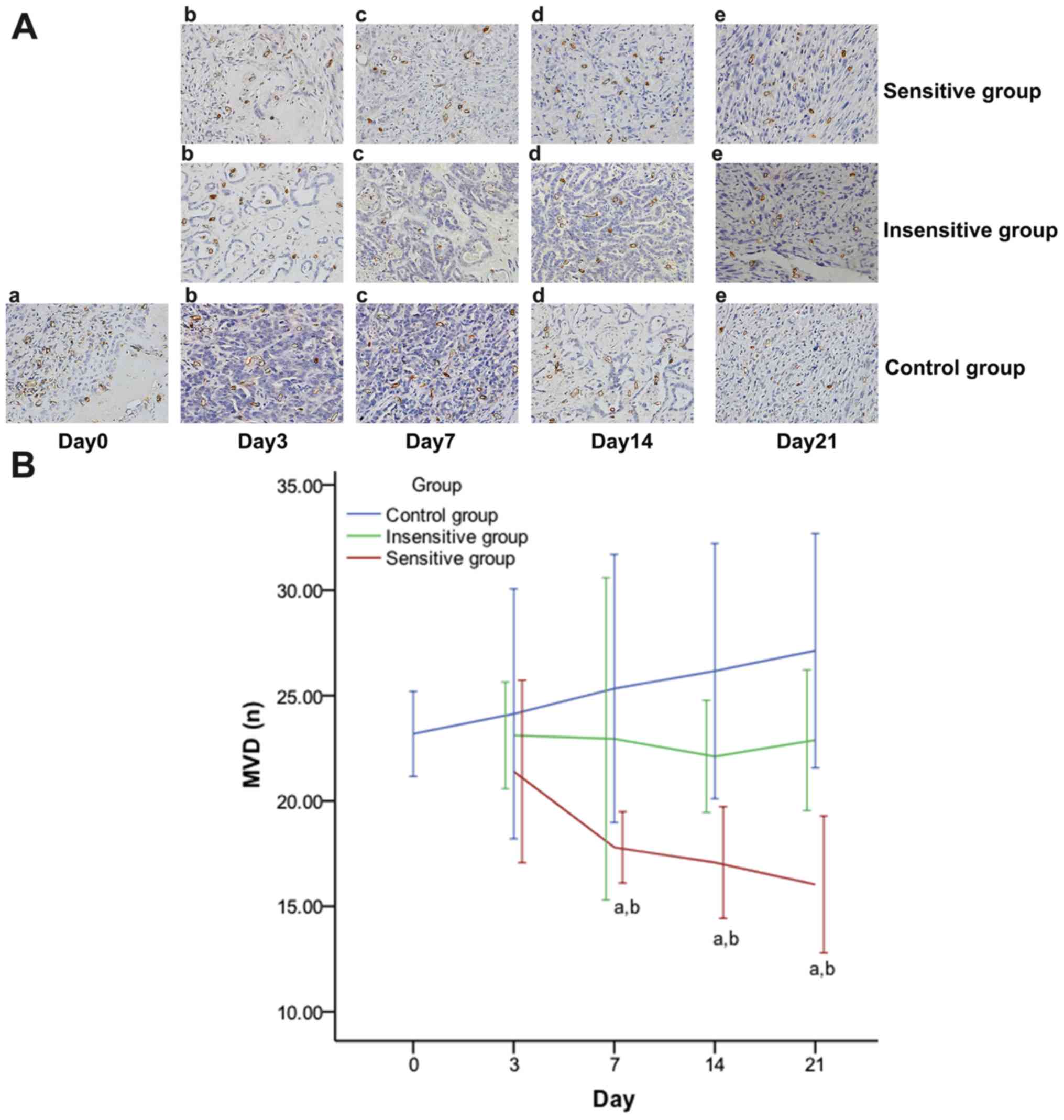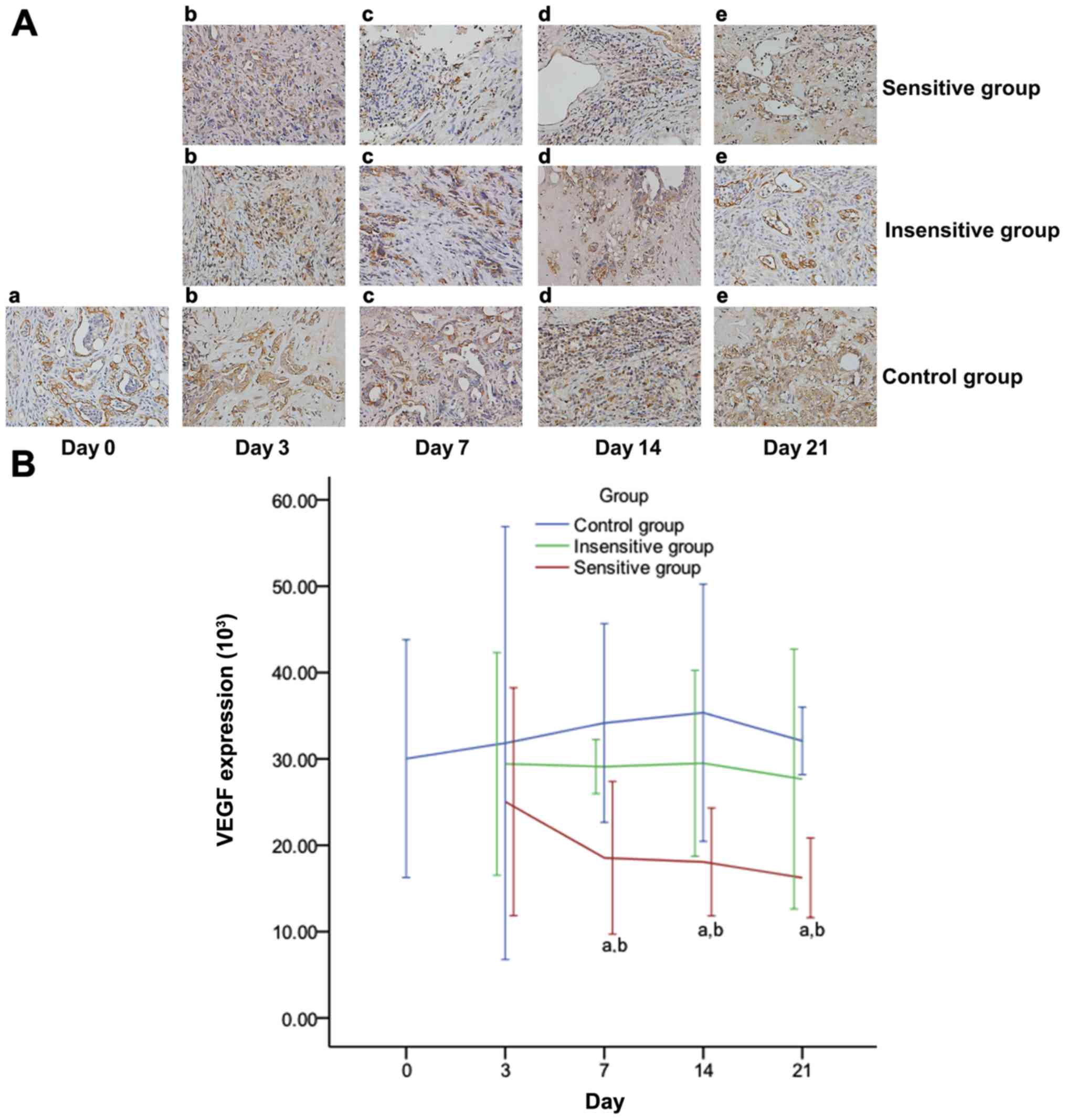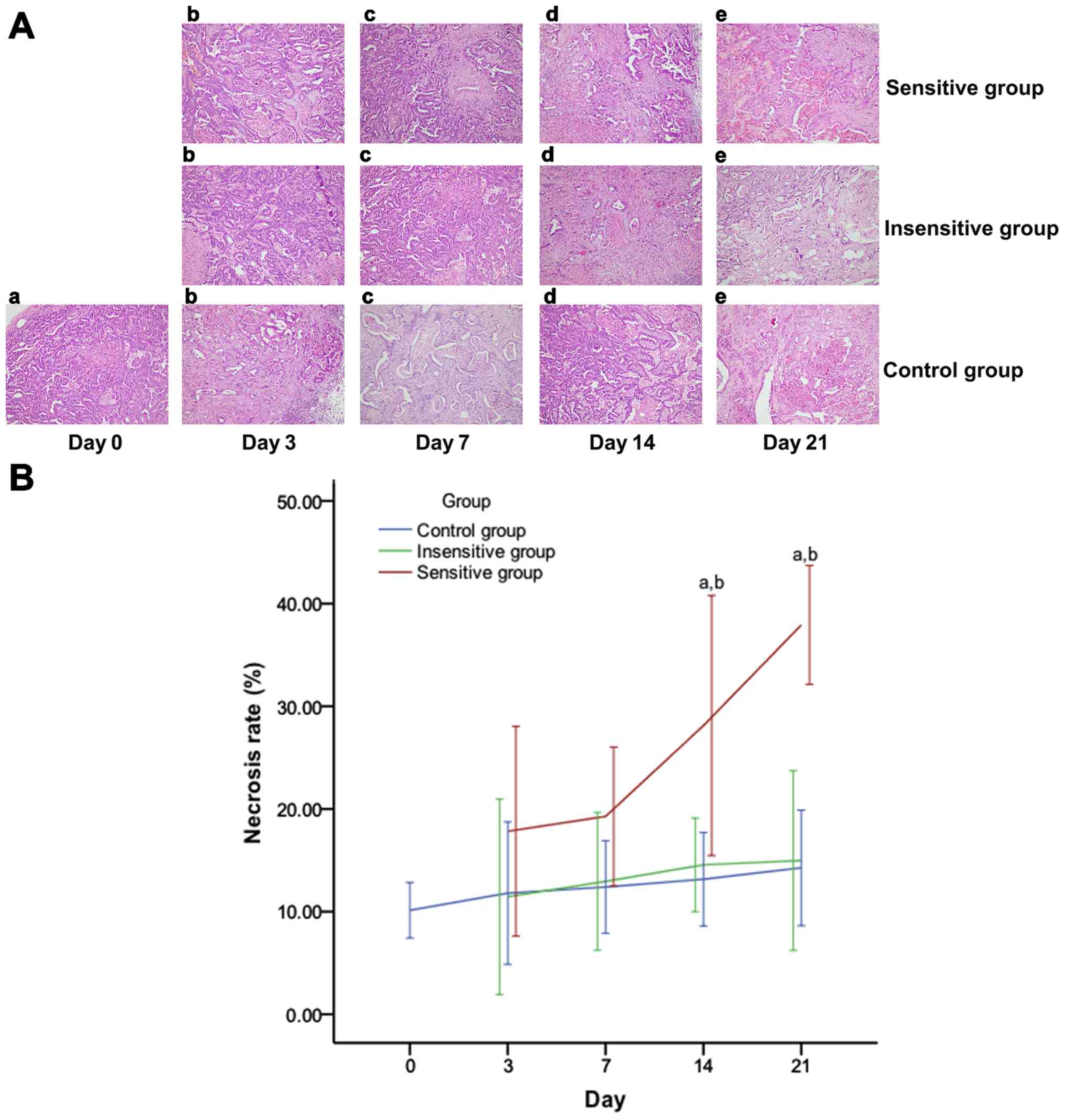|
1
|
Pan Z and Xie X: BRCA mutations in the
manifestation and treatment of ovarian cancer. Oncotarget.
8:97657–97670. 2017.PubMed/NCBI
|
|
2
|
Köbel M, Kalloger SE, Boyd N, McKinney S,
Mehl E, Palmer C, Leung S, Bowen NJ, Ionescu DN, Rajput A, et al:
Ovarian carcinoma subtypes are different diseases: Implications for
biomarker studies. PLoS Med. 5:e2322008. View Article : Google Scholar : PubMed/NCBI
|
|
3
|
Chen ZK, Cai MX, Yang J, Lin LW, Xue ES,
Huang J, Wei HF, Zhang XJ and Ke LM: Chemotherapy with PLGA
microspheres containing docetaxel decreases angiogenesis in human
hepatoma xenograft. Med Oncol. 29:62–69. 2012. View Article : Google Scholar : PubMed/NCBI
|
|
4
|
Razi Soofiyani S, Mohammad Hoseini A,
Mohammadi A, Khaze Shahgoli V, Baradaran B and Hejazi MS:
siRNA-mediated silencing of CIP2A enhances docetaxel activity
against PC-3 prostate cancer cells. Adv Pharm Bull. 7:637–643.
2017. View Article : Google Scholar : PubMed/NCBI
|
|
5
|
Liu P, Feng J, Sun M, Yuan W, Xiao R,
Xiong J, Huang X, Xiong M, Chen W, Yu X, et al: Synergistic effects
of baicalein with gemcitabine or docetaxel on the proliferation,
migration and apoptosis of pancreatic cancer cells. Int J Oncol.
51:1878–1886. 2017. View Article : Google Scholar : PubMed/NCBI
|
|
6
|
Du Z, Li L, Sun W, Wang X, Zhang Y, Chen
Z, Yuan M, Quan Z, Liu N, Hao Y, et al: HepaCAM inhibits the
malignant behavior of castration-resistant prostate cancer cells by
downregulating Notch signaling and PF-3084014 (a γ-secretase
inhibitor) partly reverses the resistance of refractory prostate
cancer to docetaxel and enzalutamide in vitro. Int J Oncol.
53:99–112. 2018.PubMed/NCBI
|
|
7
|
Armstrong SR, Narendrula R, Guo B,
Parissenti AM, McCallum KL, Cull S and Lannér C: Distinct genetic
alterations occur in ovarian tumor cells selected for combined
resistance to carboplatin and docetaxel. J Ovarian Res. 5:402012.
View Article : Google Scholar : PubMed/NCBI
|
|
8
|
Cohen JG, White M, Cruz A and
Farias-Eisner R: In 2014, can we do better than CA125 in the early
detection of ovarian cancer? World J Biol Chem. 5:286–300. 2014.
View Article : Google Scholar : PubMed/NCBI
|
|
9
|
Therasse P, Arbuck SG, Eisenhauer EA,
Wanders J, Kaplan RS, Rubinstein L, Verweij J, Van Glabbeke M, van
Oosterom AT, Christian MC, et al: New guidelines to evaluate the
response to treatment in solid tumors. European Organization for
Research and Treatment of Cancer, National Cancer Institute of the
United States, National Cancer Institute of Canada. J Natl Cancer
Inst. 92:205–216. 2000. View Article : Google Scholar : PubMed/NCBI
|
|
10
|
Leach MO, Morgan B, Tofts PS, Buckley DL,
Huang W, Horsfield MA, Chenevert TL, Collins DJ, Jackson A, Lomas
D, et al: Imaging vascular function for early stage clinical trials
using dynamic contrast-enhanced magnetic resonance imaging. Eur
Radiol. 22:1451–1464. 2012. View Article : Google Scholar : PubMed/NCBI
|
|
11
|
Padhani AR and Miles KA: Multiparametric
imaging of tumor response to therapy. Radiology. 25:348–364. 2010.
View Article : Google Scholar
|
|
12
|
Yuh WT, Mayr NA, Jarjoura D, Wu D, Grecula
JC, Lo SS, Edwards SM, Magnotta VA, Sammet S, Zhang H, et al:
Predicting control of primary tumor and survival by DCE MRI during
early therapy in cervical cancer. Invest Radiol. 44:343–350. 2009.
View Article : Google Scholar : PubMed/NCBI
|
|
13
|
Jensen LR, Huuse EM, Bathen TF, Goa PE,
Bofin AM, Pedersen TB, Lundgren S and Gribbestad IS: Assessment of
early docetaxel response in an experimental model of human breast
cancer using DCE-MRI, ex vivo HR MAS, and in vivo 1H MRS. NMR
Biomed. 23:56–65. 2010. View
Article : Google Scholar : PubMed/NCBI
|
|
14
|
Tudorica A, Oh KY, Chui SY, Roy N, Troxell
ML, Naik A, Kemmer KA, Chen Y, Holtorf ML, Afzal A, et al: Early
prediction and evaluation of breast cancer response to neoadjuvant
chemotherapy using quantitative DCE-MRI. Transl Oncol. 9:8–17.
2016. View Article : Google Scholar : PubMed/NCBI
|
|
15
|
Cebulla J, Huuse EM, Pettersen K, van der
Veen A, Kim E, Andersen S, Prestvik WS, Bofin AM, Pathak AP,
Bjørkøy G, et al: MRI reveals the in vivo cellular and vascular
response to BEZ235 in ovarian cancer xenografts with different
PI3-kinase pathway activity. Br J Cancer. 112:504–513. 2015.
View Article : Google Scholar : PubMed/NCBI
|
|
16
|
Lis E, Saha A, Peck KK, Zatcky J, Zelefsky
MJ, Yamada Y, Holodny AI, Bilsky MH and Karimi S: Dynamic
contrast-enhanced magnetic resonance imaging of osseous spine
metastasis before and 1 hour after high-dose image-guided radiation
therapy. Neurosurg Focus. 42:E92017. View Article : Google Scholar : PubMed/NCBI
|
|
17
|
Yuan SJ, Qiao TK, Qiang JW, Cai SQ and Li
RK: The value of DCE-MRI in assessing histopathological and
molecular biological features in induced rat epithelial ovarian
carcinomas. J Ovarian Res. 10:652017. View Article : Google Scholar : PubMed/NCBI
|
|
18
|
Tofts PS, Brix G, Buckley DL, Evelhoch JL,
Henderson E, Knopp MV, Larsson HB, Lee TY, Mayr NA, Parker GJ, et
al: Estimating kinetic parameters from dynamic contrast-enhanced
T(1)-weighted MRI of a diffusable tracer: Standardized quantities
and symbols. J Magn Reson Imaging. 10:223–232. 1999. View Article : Google Scholar : PubMed/NCBI
|
|
19
|
Zhang P, Chen L, Zhang Z, Lin L and Li Y:
Pharmacokinetics in rats and efficacy in murine ovarian cancer
model for solid lipid nanoparticles loading docetaxel. J Nanosci
Nanotechnol. 10:7541–7544. 2010. View Article : Google Scholar : PubMed/NCBI
|
|
20
|
Rustin GJ, Quinn M, Thigpen T, du Bois A,
Pujade-Lauraine E, Jakobsen A, Eisenhauer E, Sagae S, Greven K,
Vergote I, et al: Re: New guidelines to evaluate the response to
treatment in solid tumors (ovarian cancer). J Natl Cancer Inst.
96:487–488. 2004. View Article : Google Scholar : PubMed/NCBI
|
|
21
|
Zhou LN, Wu N, Liang Y, Gao K, Li XY and
Zhang LF: Monitoring response to gefitinib in nude mouse tumor
xenografts by 18F-FDG microPET-CT: Correlation between
18F-FDG uptake and pathological response. World J Surg
Oncol. 13:1112015. View Article : Google Scholar : PubMed/NCBI
|
|
22
|
Kovač JD, Terzić M, Mirković M, Banko B,
Đikić-Rom A and Maksimović R: Endometrioid adenocarcinoma of the
ovary: MRI findings with emphasis on diffusion-weighted imaging for
the differentiation of ovarian tumors. Acta Radiol. 57:758–766.
2016. View Article : Google Scholar : PubMed/NCBI
|
|
23
|
Khatun Z, Nurunnabi, Cho KJ, Byun Y, Bae
YH and Lee YK: Oral absorption mechanism and anti-angiogenesis
effect of taurocholic acid-linked heparin-docetaxel conjugates. J
Control Release. 177:64–73. 2014. View Article : Google Scholar : PubMed/NCBI
|
|
24
|
Whisenant JG, Sorace AG, McIntyre JO, Kang
H, Sánchez V, Loveless ME and Yankeelov TE: Evaluating treatment
responseusing DW-MRI and DCE-MRI in trastuzumab responsive and
resistant HER2-overexpressing human breast cancer xenografts.
Transl Oncol. 7:768–779. 2014. View Article : Google Scholar : PubMed/NCBI
|
|
25
|
Eisenhauer EA, Therasse P, Bogaerts J,
Schwartz LH, Sargent D, Ford R, Dancey J, Arbuck S, Gwyther S,
Mooney M, et al: New response evaluation criteria in solid tumours:
Revised RECIST guideline (version 1.1). Eur J Cancer. 45:228–247.
2009. View Article : Google Scholar : PubMed/NCBI
|
|
26
|
de Bazelaire C, Siauve N, Fournier L,
Frouin F, Robert P, Clement O, de Kerviler E and Cuenod CA:
Comprehensive model for simultaneous MRI determination of perfusion
and permeability using a blood-pool agent in rats rhabdomyosarcoma.
Eur Radiol. 15:2497–2505. 2005. View Article : Google Scholar : PubMed/NCBI
|
|
27
|
Boult JKR, Box G, Vinci M, Perryman L,
Eccles SA, Jones C and Robinson SP: Evaluation of the response of
intracranial xenografts to VEGF signaling inhibition using
multiparametric MRI. Neoplasia. 19:684–694. 2017. View Article : Google Scholar : PubMed/NCBI
|
|
28
|
Merz M, Moehler TM, Ritsch J, Bäuerle T,
Zechmann CM, Wagner B, Jauch A, Hose D, Kunz C, Hielscher T, et al:
Prognostic significance of increased bone marrow microcirculation
in newly diagnosed multiple myeloma: Results of a prospective
DCE-MRI study. Eur Radiol. 26:1404–11. 2016. View Article : Google Scholar : PubMed/NCBI
|
|
29
|
Ma L, Xu X, Zhang M, Zheng S, Zhang B,
Zhang W and Wang P: Dynamic contrast-enhanced MRI of gastric
cancer: Correlations of the pharmacokinetic parameters with
histological type, Lauren classification, and angiogenesis. Magn
Reson Imaging. 37:27–32. 2017. View Article : Google Scholar : PubMed/NCBI
|
|
30
|
Hirashima Y, Yamada Y, Tateishi U, Kato K,
Miyake M, Horita Y, Akiyoshi K, Takashima A, Okita N, Takahari D,
et al: Pharmacokinetic parameters from 3-Tesla DCE-MRI as surrogate
biomarkers of antitumor effects of bevacizumab plus FOLFIRI in
colorectal cancer with liver metastasis. Int J Cancer.
130:2359–2365. 2012. View Article : Google Scholar : PubMed/NCBI
|
|
31
|
Yang J, Kim JH, Im GH, Heo H, Yoon S, Lee
J, Lee JH and Jeon P: Evaluation of antiangiogenic effects of a new
synthetic candidate drug KR-31831 on xenografted ovarian carcinoma
using dynamic contrast enhanced MRI. Korean J Radiol. 12:602–610.
2011. View Article : Google Scholar : PubMed/NCBI
|
|
32
|
Li L, Wang K, Sun X, Wang K, Sun Y, Zhang
G and Shen B: Parameters of dynamic contrast-enhanced MRI as
imaging markers for angiogenesis and proliferation in human breast
cancer. Med Sci Monit. 21:376–382. 2015. View Article : Google Scholar : PubMed/NCBI
|
|
33
|
Yao WW, Zhang H, Ding B, Fu T, Jia H, Pang
L, Song L, Xu W, Song Q, Chen K, et al: Rectal cancer: 3D dynamic
contrast-enhanced MRI; correlation with microvascular density and
clinicopathological features. Radiol Med. 116:366–374. 2011.
View Article : Google Scholar : PubMed/NCBI
|
|
34
|
Folkman J: Tumor angiogenesis: Therapeutic
implications. N Engl J Med. 285:1182–1186. 1971. View Article : Google Scholar : PubMed/NCBI
|
|
35
|
Mikalsen LT, Dhakal HP, Bruland OS,
Nesland JM and Olsen DR: Quantification of angiogenesis in breast
cancer by automated vessel identification in CD34
immunohistochemical sections. Anticancer Res. 31:4053–4060.
2011.PubMed/NCBI
|
|
36
|
Bando H: Vascular endothelial growth
factor and bevacitumab in breast cancer. Breast Cancer. 14:163–173.
2007. View Article : Google Scholar : PubMed/NCBI
|
|
37
|
Hayes DF, Miller K and Sledge G:
Angiogenesis as targeted breast cancer therapy. Breast. 16 (Suppl
2):S17–S19. 2007. View Article : Google Scholar : PubMed/NCBI
|
|
38
|
Ji Y, Hayashi K, Amoh Y, Tsuji K, Yamauchi
K, Yamamoto N, Tsuchiya H, Tomita K, Bouvet M and Hoffman RM: The
camptothecin derivative CPT-11 inhibits angiogenesis in a
dual-color imageable orthotopic metastatic nude mouse model of
human colon cancer. Anticancer Res. 27:713–718. 2007.PubMed/NCBI
|
|
39
|
Zhang Q, Kang X and Zhao W: Antiangiogenic
effect of low-dose cyclophosphamide combined with ginsenoside Rg3
on Lewis lung carcinoma. Biochem Biophys Res Commun. 342:824–828.
2006. View Article : Google Scholar : PubMed/NCBI
|
|
40
|
Zhang M, Tao W, Pan S, Sun X and Jiang H:
Low-dose metronomic chemotherapy of paclitaxel synergizes with
cetuximab to suppress human colon cancer xenografts. Anticancer
Drugs. 20:355–363. 2009. View Article : Google Scholar : PubMed/NCBI
|
|
41
|
Chen J, Qian T, Zhang H, Wei C, Meng F and
Yin H: Combining dynamic contrast enhanced magnetic resonance
imaging and microvessel density to assess the angiogenesis after
PEI in a rabbit VX2 liver tumor model. Magn Reson Imaging.
34:177–182. 2016. View Article : Google Scholar : PubMed/NCBI
|
|
42
|
Yuan A, Lin CY, Chou CH, Shih CM, Chen CY,
Cheng HW, Chen YF, Chen JJ, Chen JH, Yang PC, et al: Functional and
structural characteristics of tumor angiogenesis in lung cancers
overexpressing different VEGF isoforms assessed by DCE- and
SSCE-MRI. PLoS One. 6:e160622011. View Article : Google Scholar : PubMed/NCBI
|
|
43
|
Wu L, Lv P, Zhang H, Fu C, Yao X, Wang C,
Zeng M, Li Y and Wang X: Dynamic contrast-enhanced (DCE) MRI
assessment of microvascular characteristics in the murine
orthotopic pancreatic cancer model. Magn Reson Imaging. 33:737–760.
2015. View Article : Google Scholar : PubMed/NCBI
|















